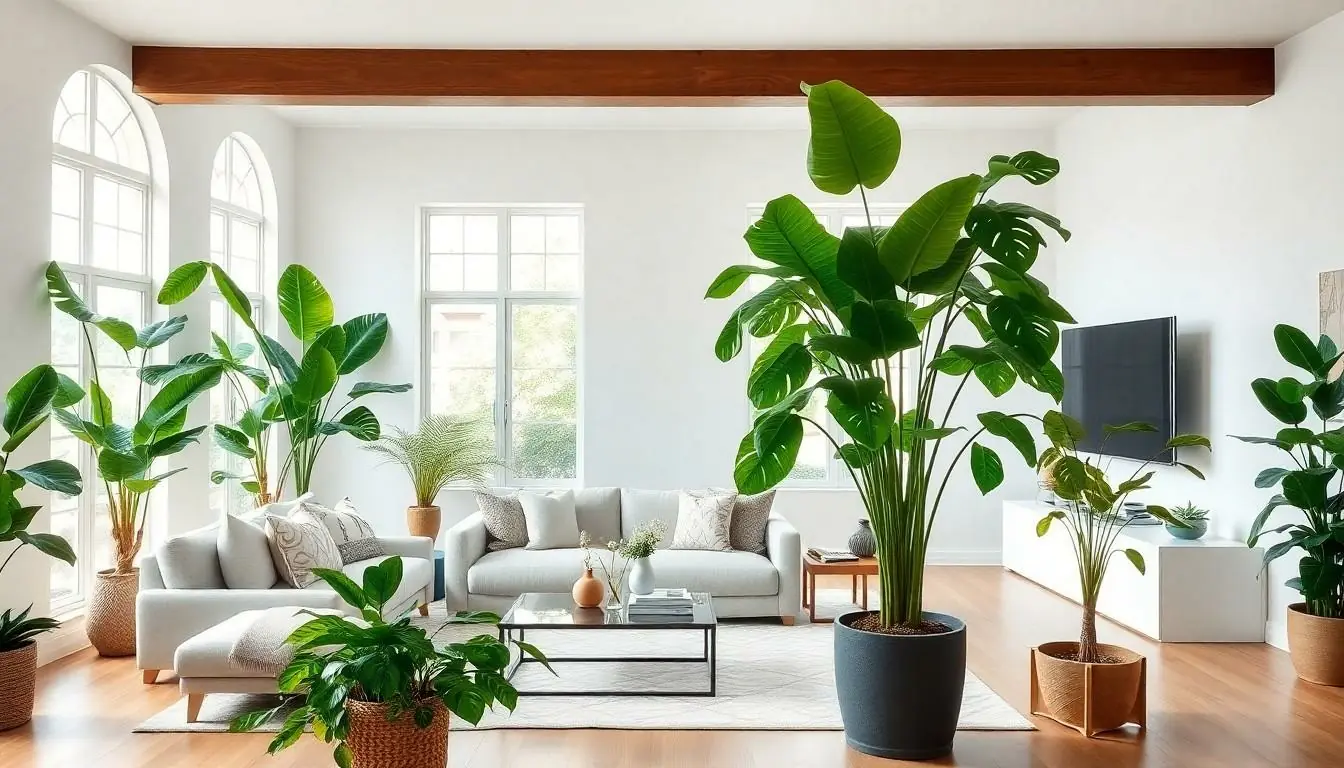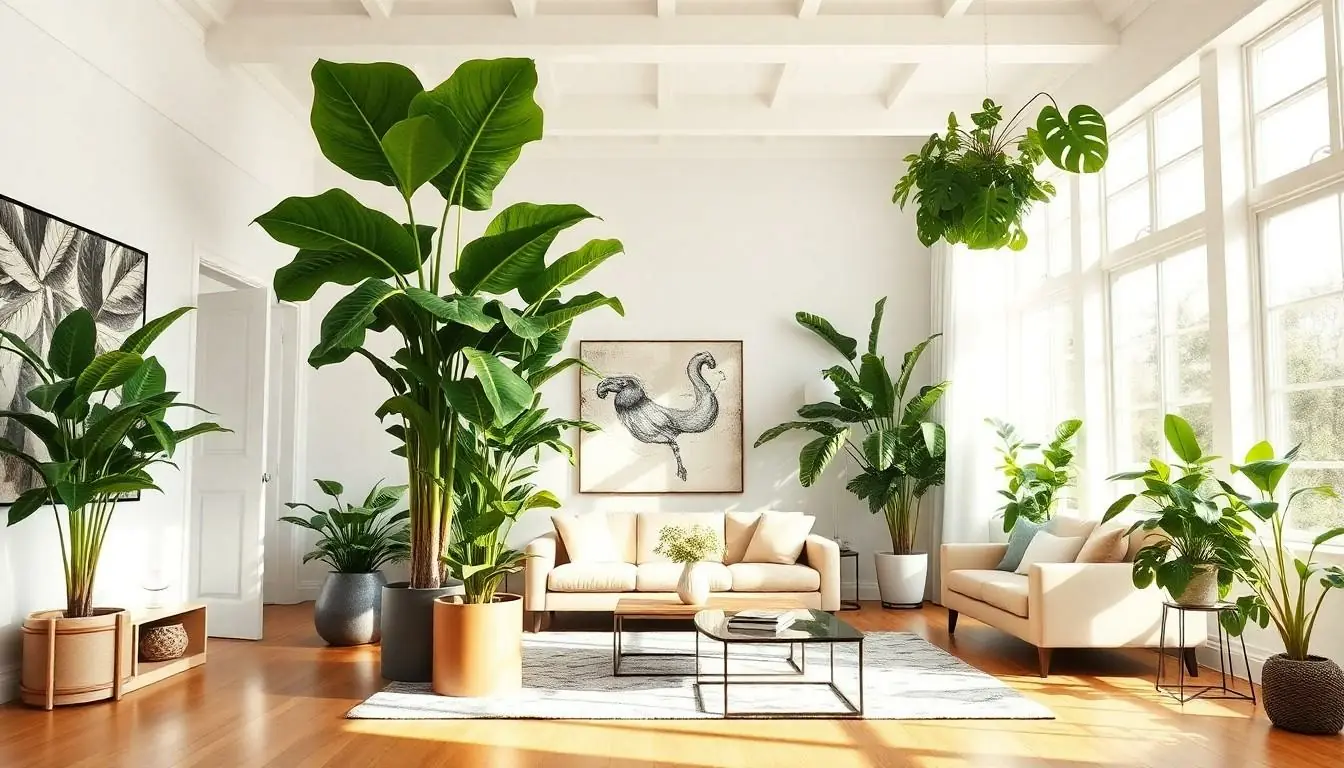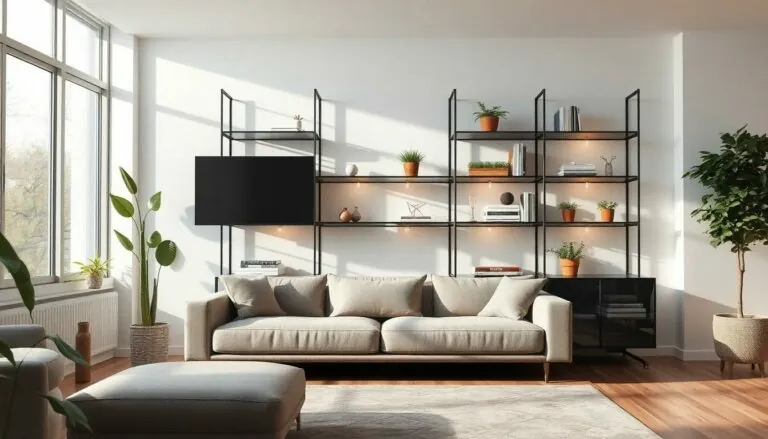Imagine transforming your living space into a lush jungle without ever leaving your home. Large indoor house plants aren’t just oversized decorations; they’re nature’s way of saying, “Hey, let’s breathe better and live happier!” These green giants can turn a dull corner into a vibrant focal point, all while silently working to improve air quality and boost your mood.
Table of Contents
ToggleOverview of Large Indoor House Plants
Large indoor house plants serve a crucial role in interior design. They not only bring life to a space but also act as natural air purifiers. Popular types include the fiddle leaf fig, monstera, and rubber plant. Each variety has unique attributes that appeal to different aesthetics and care requirements.
Selecting appropriate locations within the home is essential for maximizing their beauty and health. Plants such as the snake plant and pothos thrive in low light conditions, making them ideal for various rooms. Bright, indirect light suits species like the palm and bird of paradise, enhancing their growth and vibrancy.
Care routines vary based on the species. Overwatering can be detrimental, so it’s important to understand individual needs. Fertilizing during the growing season promotes healthy foliage and overall vitality. Additionally, repotting every couple of years supports root development and prevents crowding.
Indoor plants contribute positively to well-being. Studies indicate that they reduce stress levels and boost concentration. An abundance of greenery can create a calming atmosphere, making homes more inviting. Incorporating large house plants into daily life results in improved air quality and mood enhancement.
Choosing plants adds personality to any room. They can act as statement pieces or subtle accents, depending on the desired effect. Mixing and matching different sizes and shapes creates visual interest. With the right selection and care, large indoor plants elevate living spaces, making them more vibrant and enjoyable.
Benefits of Large Indoor House Plants

Large indoor house plants offer numerous advantages that enhance living spaces. They contribute positively to both aesthetics and indoor environments.
Improved Air Quality
Large house plants significantly improve air quality. They filter pollutants such as formaldehyde and benzene, which often linger in indoor air. These plants also increase humidity levels, promoting respiratory health. By absorbing carbon dioxide and releasing oxygen, they enhance overall air circulation. Studies indicate that indoor plants can reduce airborne toxins by up to 87% over 24 hours. With larger foliage, these plants offer greater surface area for photosynthesis, boosting purifying effects.
Aesthetic Appeal
Large indoor house plants create stunning focal points in any room. They draw attention and provide vibrant colors, breaking monotony in interior design. Statement plants, such as fiddle leaf figs and monstera, become central elements in home decor. Textured leaves and varying heights add depth to spaces, making them feel more inviting. Incorporating these plants helps balance and complement furniture styles, enhancing visual interest. Plant placement around furniture can transform dull corners into lively areas, showcasing unique personality throughout a home.
Popular Types of Large Indoor House Plants
Large indoor house plants come in various types, each offering unique characteristics and benefits. Here are some popular options to consider.
Ficus Trees
Ficus trees are known for their dramatic foliage and height, making them excellent focal points in any room. The Ficus elastica, also known as the rubber tree, features glossy leaves and can grow between 6 to 10 feet tall. It thrives in bright, indirect light and prefers slightly moist soil. Care involves occasional pruning to maintain shape and regular dusting of leaves for optimal health. Ficus trees can significantly enhance indoor air quality, filtering harmful toxins and promoting a healthier environment.
Monstera Deliciosa
Monstera deliciosa captures attention with its unique split leaves, which can grow up to three feet wide. This tropical plant prefers warm, humid conditions and indirect light, thriving in well-drained soil. Growth can reach 6 to 10 feet, making it suitable for corners or larger spaces. Watering requires moderation, allowing the soil to dry slightly between waterings. Monstera’s ability to purify air adds to its allure, making it a popular choice for enhancing indoor aesthetics while fostering well-being.
Rubber Plants
Rubber plants are favored for their striking appearance and ease of care. Featuring thick, dark green leaves, these plants can reach impressive heights between 6 and 10 feet. They thrive in bright, indirect light but tolerate low light conditions, adding flexibility to placement options. Regular watering ensures the soil remains slightly moist, while occasional fertilizing during the growing season promotes vibrant growth. Rubber plants also contribute to improved air quality, filtering indoor pollutants and creating a healthier living space.
Care Requirements for Large Indoor House Plants
Large indoor house plants require specific care to thrive in a home environment. Ensuring the right conditions promotes their growth and health.
Light Needs
Large indoor house plants typically prefer bright, indirect light. Fiddle leaf figs demand two to six hours of filtered sunlight, making placement near east or west-facing windows ideal. Monstera thrives in warm, humid conditions with indirect light, enhancing its unique foliage. Rubber plants can adapt, tolerating low light but growing best in moderate brightness. It’s crucial to avoid direct sunlight, as it can scorch leaves and impede growth.
Watering Guidelines
Watering large indoor house plants requires attention to detail. Soil for these plants should be allowed to dry out partially between watering sessions. Fiddle leaf figs prefer a thorough soaking every one to two weeks, while monstera benefits from slightly higher moisture levels. Assess the top inch of soil for dryness to determine watering needs. Overwatering can lead to root rot, so observation ensures a healthy balance.
Fertilization Tips
Fertilization enhances the growth of large indoor house plants. Using a balanced, water-soluble fertilizer during the growing season supports their nutrient needs. Apply fertilizer every four to six weeks, diluting it to avoid overwhelming the plants. Innovative options, such as organic compost, can also provide essential nutrients. Monitoring the plants’ response to fertilization helps adjust feeding routines for optimal health.
Common Pests and Diseases
Large indoor house plants can attract various pests and diseases. Familiarizing oneself with these issues aids in early detection and treatment. Common pests include spider mites, aphids, and scale insects. Spider mites appear as tiny dots on leaves, often causing discoloration and webbing. Aphids cluster on new growth and can stunt plant development. Scale insects appear as small bumps on stems and leaves, leading to yellowing and leaf drop.
Fungal infections often affect large house plants, especially in humid conditions. Root rot stems from overwatering, manifesting in wilting, yellowing leaves, and mushy stems. Recognizing these signs promptly helps prevent further damage. Powdery mildew appears as a white, powdery substance on leaves, thriving in poor air circulation and high humidity.
To combat pests, regularly inspecting plants proves effective. Employing natural remedies like neem oil or insecticidal soap helps eliminate infestations without harmful chemicals. Quarantining new plants for at least two weeks aids in preventing the spread of pests and diseases.
Maintaining proper care also strengthens plants’ defenses. Ensuring adequate air circulation reduces the risk of fungal infections and pest attraction. Using well-draining soil helps prevent water retention, mitigating root rot risks. Organic fertilizers can also enhance overall plant health, making them less susceptible to issues.
Vigilance and prompt action can significantly reduce the impact of pests and diseases on large indoor house plants. Addressing these concerns directly contributes to the plants’ longevity and vitality.
Large indoor house plants are more than just decorative elements; they’re vital contributors to a healthier living environment. By selecting the right plants and providing proper care, individuals can enjoy the numerous benefits these green companions offer.
From improving air quality to enhancing mood and aesthetics, large plants can truly transform any space. They serve as striking focal points that bring life and personality into homes. With a bit of attention and the right conditions, these plants can thrive, making them a worthwhile investment for anyone looking to elevate their indoor atmosphere. Embracing large indoor house plants is a step toward creating a vibrant and inviting home.





